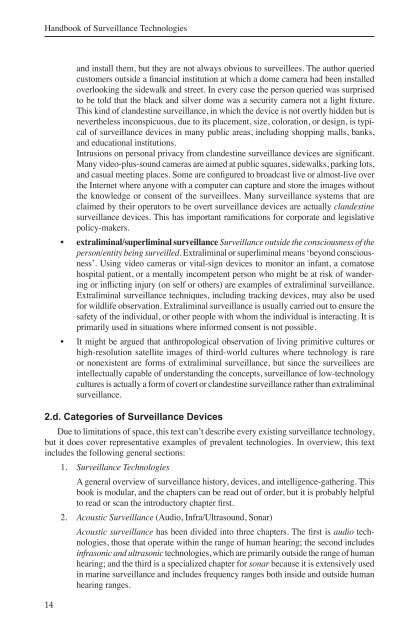Handbook of Surveillance Technologies (3rd Ed) - The Real Faces of ...
Handbook of Surveillance Technologies (3rd Ed) - The Real Faces of ...
Handbook of Surveillance Technologies (3rd Ed) - The Real Faces of ...
You also want an ePaper? Increase the reach of your titles
YUMPU automatically turns print PDFs into web optimized ePapers that Google loves.
<strong>Handbook</strong> <strong>of</strong> <strong>Surveillance</strong> <strong>Technologies</strong><br />
14<br />
and install them, but they are not always obvious to surveillees. <strong>The</strong> author queried<br />
customers outside a financial institution at which a dome camera had been installed<br />
overlooking the sidewalk and street. In every case the person queried was surprised<br />
to be told that the black and silver dome was a security camera not a light fixture.<br />
This kind <strong>of</strong> clandestine surveillance, in which the device is not overtly hidden but is<br />
nevertheless inconspicuous, due to its placement, size, coloration, or design, is typical<br />
<strong>of</strong> surveillance devices in many public areas, including shopping malls, banks,<br />
and educational institutions.<br />
Intrusions on personal privacy from clandestine surveillance devices are significant.<br />
Many video-plus-sound cameras are aimed at public squares, sidewalks, parking lots,<br />
and casual meeting places. Some are configured to broadcast live or almost-live over<br />
the Internet where anyone with a computer can capture and store the images without<br />
the knowledge or consent <strong>of</strong> the surveillees. Many surveillance systems that are<br />
claimed by their operators to be overt surveillance devices are actually clandestine<br />
surveillance devices. This has important ramifications for corporate and legislative<br />
policy-makers.<br />
• extraliminal/superliminal surveillance <strong>Surveillance</strong> outside the consciousness <strong>of</strong> the<br />
person/entity being surveilled. Extraliminal or superliminal means ‘beyond consciousness’.<br />
Using video cameras or vital-sign devices to monitor an infant, a comatose<br />
hospital patient, or a mentally incompetent person who might be at risk <strong>of</strong> wandering<br />
or inflicting injury (on self or others) are examples <strong>of</strong> extraliminal surveillance.<br />
Extraliminal surveillance techniques, including tracking devices, may also be used<br />
for wildlife observation. Extraliminal surveillance is usually carried out to ensure the<br />
safety <strong>of</strong> the individual, or other people with whom the individual is interacting. It is<br />
primarily used in situations where informed consent is not possible.<br />
• It might be argued that anthropological observation <strong>of</strong> living primitive cultures or<br />
high-resolution satellite images <strong>of</strong> third-world cultures where technology is rare<br />
or nonexistent are forms <strong>of</strong> extraliminal surveillance, but since the surveillees are<br />
intellectually capable <strong>of</strong> understanding the concepts, surveillance <strong>of</strong> low-technology<br />
cultures is actually a form <strong>of</strong> covert or clandestine surveillance rather than extraliminal<br />
surveillance.<br />
2.d. Categories <strong>of</strong> <strong>Surveillance</strong> Devices<br />
Due to limitations <strong>of</strong> space, this text can’t describe every existing surveillance technology,<br />
but it does cover representative examples <strong>of</strong> prevalent technologies. In overview, this text<br />
includes the following general sections:<br />
1. <strong>Surveillance</strong> <strong>Technologies</strong><br />
A general overview <strong>of</strong> surveillance history, devices, and intelligence-gathering. This<br />
book is modular, and the chapters can be read out <strong>of</strong> order, but it is probably helpful<br />
to read or scan the introductory chapter first.<br />
2. Acoustic <strong>Surveillance</strong> (Audio, Infra/Ultrasound, Sonar)<br />
Acoustic surveillance has been divided into three chapters. <strong>The</strong> first is audio technologies,<br />
those that operate within the range <strong>of</strong> human hearing; the second includes<br />
infrasonic and ultrasonic technologies, which are primarily outside the range <strong>of</strong> human<br />
hearing; and the third is a specialized chapter for sonar because it is extensively used<br />
in marine surveillance and includes frequency ranges both inside and outside human<br />
hearing ranges.



